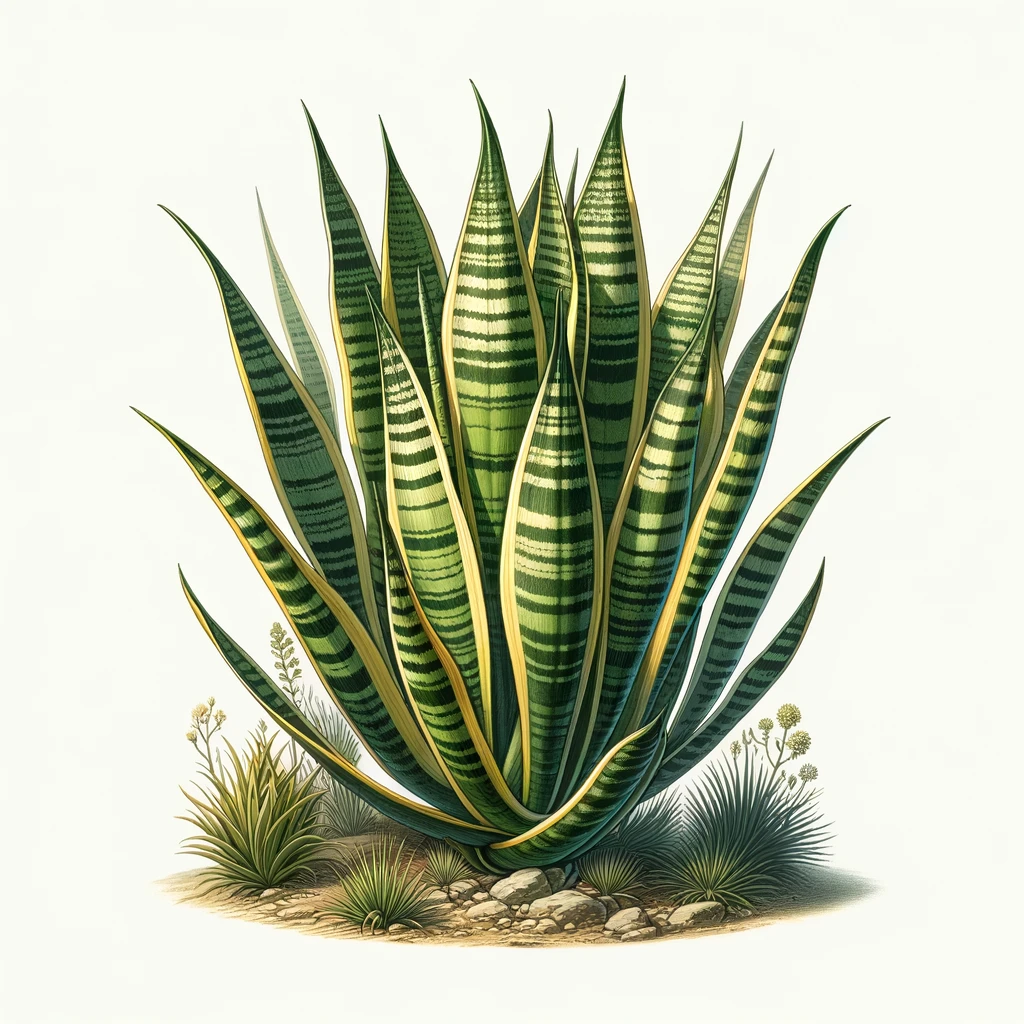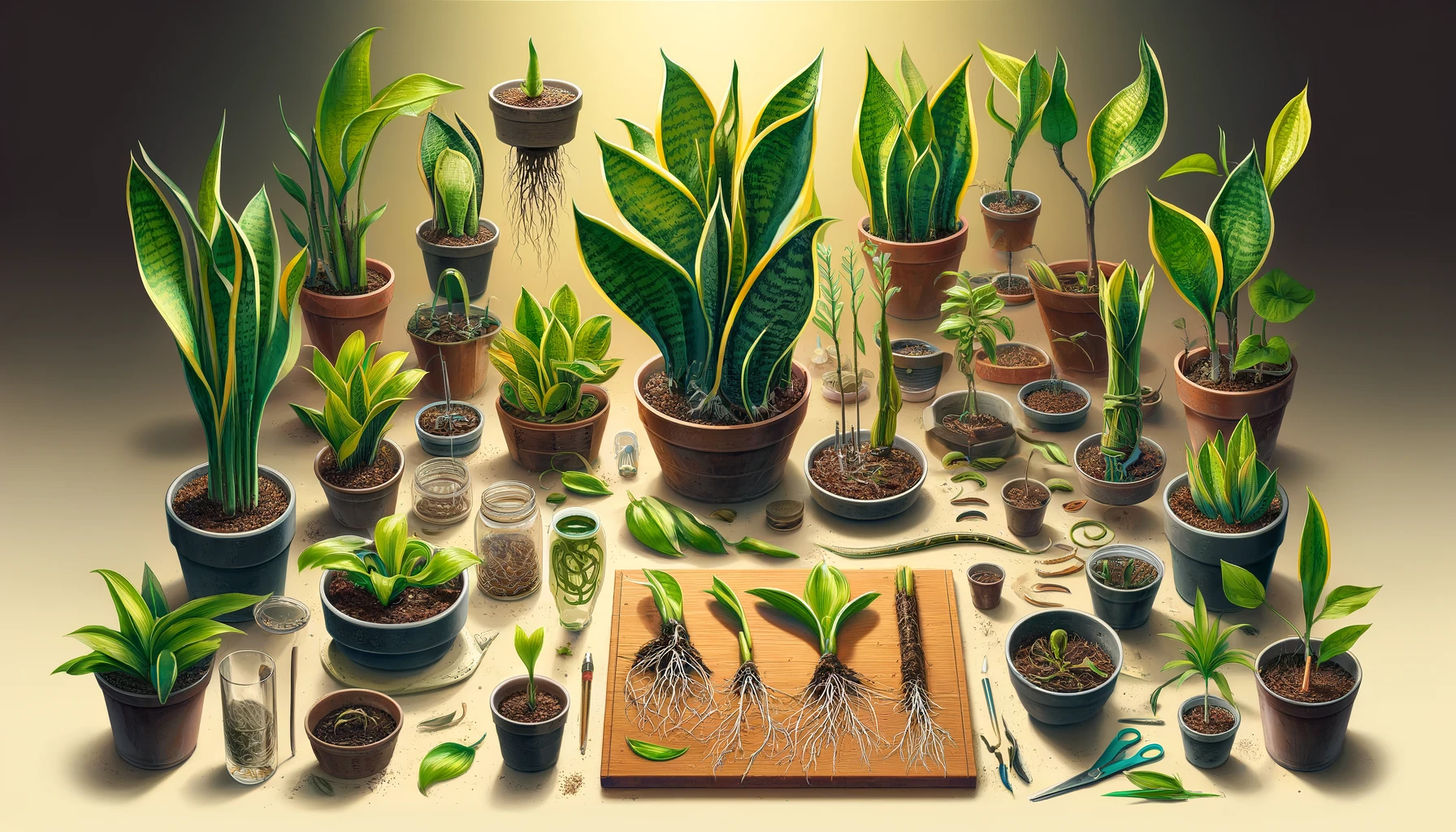Understanding Snake Plants
Snake plants, scientifically known as Sansevieria or more recently classified under the Dracaena genus, are renowned for their striking appearance and resilience, making them a popular choice for both novice and experienced plant enthusiasts. These hardy perennials are native to West Africa, thriving in dry, tropical savannas where conditions are tough.
Botanical Profile:
- Common Names: Snake plant, mother-in-law’s tongue, viper’s bowstring hemp
- Botanical Name: Dracaena trifasciata
- Family: Asparagaceae
- Plant Type: Evergreen perennial
- Mature Size: In its native habitat, it can grow from 6 inches to 12 feet tall. As a houseplant, it typically reaches 2 to 5 feet in height.
Native Habitat:
Snake plants are adapted to environments in West Africa that vary from arid deserts to tropical highlands, which contributes to their versatility in various home settings. They prefer indirect sunlight but can tolerate lower light levels, making them ideal for indoor environments where natural light is limited.
Growth and Care:
Snake plants are incredibly low-maintenance, requiring minimal water and thriving on neglect. Their leaves grow upright and have a leathery texture, often featuring horizontal stripes of green and yellow. These plants are particularly effective at filtering indoor air, capable of removing toxins such as benzene, formaldehyde, trichloroethylene, xylene, and toluene.
By integrating snake plants into your home or office, you not only enhance the aesthetic value of your space but also improve air quality, making them a functional and attractive addition to any indoor environment. Their ability to thrive under low care makes them a perfect start for beginners looking to green their spaces with minimal effort.

AI Generated Image
Varieties of Snake Plants
Snake plants, known botanically as Dracaena trifasciata, come in a range of varieties, each distinguished by unique patterns and growth forms. These variations make snake plants versatile and decorative, suitable for different interior design styles. Here’s a closer look at some popular varieties that have captured the interest of plant lovers worldwide.
Dracaena trifasciata ‘Laurentii’
The ‘Laurentii’ is perhaps the most recognizable snake plant, featuring dark green leaves with golden yellow edges. It can grow up to 4 feet tall and adds a striking vertical element to room decor.
Dracaena cylindrica
Also known as the cylindrical snake plant, Dracaena cylindrica sports round, stiff leaves that can grow several feet in length. The leaves stand upright and point skyward, offering a different texture and silhouette compared to other varieties.
Dracaena trifasciata ‘Hahnii’
Known as the bird’s nest snake plant, ‘Hahnii’ forms a rosette of leaves that resembles a bird’s nest. This compact variety grows only about 6 inches tall, making it ideal for small spaces and tabletops.
Dracaena trifasciata ‘Twisted Sister’
The ‘Twisted Sister’ variety has leaves that twist as they grow, creating a dynamic and whimsical appearance. Its leaves are variegated with green and yellow stripes, bringing a vibrant splash of color to any setting.
Dracaena trifasciata ‘Bantel’s Sensation’
This variety stands out with its narrow leaves and white vertical striping. ‘Bantel’s Sensation’ is a taller variety, reaching up to 3 feet in height, and is known for its striking, minimalist aesthetic.
Dracaena trifasciata ‘Whale Fin’
Characterized by its broad, paddle-like leaves, the ‘Whale Fin’ can grow impressively large, making it a statement piece in any interior. Each leaf is uniquely shaped, often sporting a mix of green hues and light variegation.
Choosing Your Snake Plant
When selecting a snake plant for your home, consider the light conditions and available space. Some varieties, like the ‘Laurentii’, are tolerant of low light, making them suitable for rooms with few windows. Others, such as ‘Whale Fin’, require more space to accommodate their larger size.
Snake plants are not just decorative; they are also highly functional, purifying the air and improving indoor environments. Each variety offers its own unique charm, enabling you to find the perfect snake plant to match your aesthetic preferences and care capabilities.

AI Generated Image
Optimal Growing Conditions for Snake Plants
Snake plants, also known as Dracaena trifasciata, are favored for their adaptability and ease of care, making them ideal houseplants for both beginners and seasoned gardeners. To ensure that your snake plants thrive, it’s important to understand their preferred growing conditions. Here’s a detailed guide on how to provide the best environment for your snake plants.
Light Requirements
Snake plants are remarkably tolerant of various lighting conditions. They prefer indirect, bright light but will also thrive in low light and can tolerate some direct sunlight. However, too much direct sun can cause the leaves to scorch, while too little light may lead to stunted growth and duller leaf color. A north-facing window is ideal for maintaining the vibrant color of the leaves without exposing the plant to harsh sunlight.
Soil Type
The right soil is crucial for the health of your snake plant. They need a well-draining potting mix to prevent root rot. A mixture of regular potting soil with some sand and perlite is perfect, as it ensures adequate drainage. Alternatively, cactus or succulent mixes are also excellent choices due to their well-draining properties.
Watering Practices
Watering is the most critical aspect of snake plant care. These plants are drought-resistant, meaning they do better with less water. During the growing season (spring and summer), water your snake plant only when the top inch of soil is completely dry. In winter, reduce watering to once a month or less, depending on the humidity and temperature of your home. Always ensure that water does not sit in the rosette of the leaves or at the bottom of the container, as this can cause rot.
Temperature and Humidity
Snake plants prefer warmer temperatures and will thrive in conditions between 55°F and 85°F (13°C to 29°C). They are not frost-tolerant and should not be exposed to temperatures below 50°F (10°C). While snake plants can adapt to low humidity levels, they prefer a moderate humidity environment. If your home is very dry, especially in winter, an occasional misting or a humidity tray can help.
Fertilization
Fertilize your snake plant sparingly to avoid overfeeding, which can harm the plant more than it helps. Use a balanced, water-soluble fertilizer diluted to half strength, once during the spring and once in the summer. Avoid fertilizing in the fall and winter when the plant’s growth naturally slows down.
By following these guidelines, your snake plants will not only survive but thrive, enhancing your home with their unique and striking foliage. This section has been optimized for the keyword “snake plant” by focusing on practical care tips that help ensure the health and beauty of these versatile plants.

AI Generated Image
Nutrition and Fertilization of Snake Plants
Snake plants (Dracaena trifasciata) are low-maintenance and generally require minimal feeding compared to other houseplants. Proper fertilization, however, can help maintain their vigor and enhance their architectural leaf structure. Understanding the right type and frequency of fertilizer applications is key to supporting the health of your snake plants without causing nutrient overload.
Types of Fertilizers
Snake plants benefit from a balanced fertilizer with an equal ratio of nitrogen, phosphorus, and potassium (10-10-10 or 20-20-20). These nutrients support overall health, promoting sturdy leaf growth and vibrant color. Opt for a water-soluble or liquid fertilizer for easy application and consistent distribution.
Fertilization Schedule
The best times to fertilize snake plants are during the active growing seasons—spring and early summer. This schedule aligns with their natural growth cycle, allowing the plants to utilize the nutrients effectively:
- Spring: Apply a balanced fertilizer diluted to half strength as new growth begins to appear. This initial feed supports emerging leaves and compensates for any nutrient depletion in the soil.
- Mid-Summer: A second application midway through the summer can help sustain growth and vitality as the plant continues to develop.
Avoiding Over-Fertilization
It is crucial to avoid over-fertilizing snake plants, as they are susceptible to fertilizer burn, which can lead to salt buildup in the soil and root damage. Here are some tips to prevent over-fertilization:
- Always dilute the fertilizer to half the recommended strength to avoid overwhelming the plant with nutrients.
- Ensure the soil is moist before applying fertilizer to prevent root burn.
- Limit fertilizing to only twice a year—over-fertilization can do more harm than good by leading to weak, floppy growth.
Signs of Nutritional Deficiencies
While snake plants are robust, they can occasionally show signs of nutritional deficiencies:
- Nitrogen Deficiency: Older leaves may turn yellow and the overall growth may slow down.
- Potassium Deficiency: Tips and edges of leaves might turn brown and crispy.
- Phosphorus Deficiency: Leaves may become dark green or purplish, with a reduced growth rate.
By adhering to these fertilization guidelines, you can help ensure your snake plants remain healthy and vibrant. Monitoring their response to feeding and adjusting your care regimen accordingly can prevent issues related to over or under-fertilization. This section is optimized for the keyword “snake plant” by providing targeted advice on the nutrition and fertilization practices that are best suited for this specific houseplant.

AI Generated Image
Seasonal Care and Overwintering Snake Plants
Snake plants (Dracaena trifasciata) are exceptionally hardy and adapt well to indoor environments, but they still benefit from seasonal care adjustments to match their natural growth cycle. Understanding how to care for snake plants throughout the year and particularly during the colder months can ensure they stay healthy and vibrant.
Spring and Summer Care
During the warmer months, snake plants enter their growth phase and may require more attention:
- Watering: Increase watering slightly as the plant’s growth accelerates, always allowing the soil to dry completely between waterings.
- Light: Position your snake plants where they can receive plenty of indirect light. Some direct morning sun can be beneficial but avoid harsh afternoon sun which can scorch the leaves.
- Repotting: Spring is the ideal time for repotting snake plants if they have outgrown their pots. Choose a pot only slightly larger than the previous one, as too much space can lead to excess soil moisture and root rot.
Fall and Winter Care
As temperatures drop and daylight decreases, snake plants will slow down and enter a dormant period:
- Watering: Reduce watering during the winter months. Water only once the soil has dried out thoroughly, which may be once a month or less depending on indoor heating and humidity levels.
- Temperature: Keep your snake plants away from drafty windows and doors, as they are sensitive to cold drafts. Ideal temperatures are between 55°F and 85°F (13°C to 29°C).
- Fertilizer: Do not fertilize snake plants during the winter, as the plants are not actively growing and excess nutrients can accumulate in the soil, potentially harming the plant.
Overwintering Tips
To successfully overwinter snake plants, consider these additional tips:
- Humidity: Indoor heating can reduce humidity levels drastically in winter. While snake plants tolerate low humidity, using a humidifier or placing a water tray near heating sources can help maintain a comfortable environment.
- Inspection: Regularly inspect for pests and diseases, which can be more prevalent in winter due to the reduced strength of the plant and indoor heat attracting pests like spider mites.
- Light: Maximize light exposure by cleaning the leaves and placing the plant in the brightest indoor area available, as natural light is lower during winter.
By adjusting the care of your snake plants according to the season, you can mimic their natural habitat, promoting year-round health. This section enhances the article’s SEO for the keyword “snake plant” by detailing specific seasonal care tips that are crucial for the thriving of these robust houseplants during different times of the year.

AI Generated Image
Propagation Techniques for Snake Plants
Propagating snake plants (Dracaena trifasciata) is a simple and effective way to expand your collection or share with friends. These plants can be propagated by several methods, each suitable for different types of growth and condition of the plant. Here’s a guide to propagating your snake plants, enhancing your indoor garden without needing to purchase new plants.
Propagation by Division
Division is best suited for mature snake plants that have grown several leaf clusters. It’s a straightforward method:
- Step 1: Carefully remove your snake plant from its pot and clear the dirt from its roots.
- Step 2: Identify natural separations between the clusters of leaves, which are typically connected by a rhizome.
- Step 3: Using a clean, sharp knife, cut through the rhizome to separate the sections, ensuring each new section has roots attached.
- Step 4: Pot each section in fresh, well-draining potting mix suitable for succulents or cacti.
Propagation by Leaf Cuttings
Leaf cuttings are ideal for propagating new snake plants from a few leaves or when the plant has sustained damage:
- Step 1: Select a healthy, full-grown leaf and cut it near the base with a clean, sharp knife or scissors.
- Step 2: Allow the cut end of the leaf to callous over for a day or two to prevent rot.
- Step 3: Plant the leaf cutting in a moist potting mix designed for succulents, positioning it about an inch deep.
- Step 4: Water sparingly, just enough to moisten the soil and maintain minimal moisture until roots begin to develop.
Care for Propagated Plants
Once your new snake plants have been potted:
- Light: Place them in indirect light where they will not be scorched by the sun but still benefit from bright conditions.
- Water: Keep the soil slightly moist but not wet, allowing the top inch to dry out before watering again.
- Growth Monitoring: It can take a few weeks to a few months for new roots to form. Patience is key during this period.
Propagating snake plants not only increases your plant count but also engages you in an enjoyable gardening activity that enhances your living space. This section is optimized for the keyword “snake plant” by providing detailed, easy-to-follow instructions for the propagation techniques that help readers successfully increase their snake plant collections.

AI Generated Image
Styling and Decorating with Snake Plants
Snake plants (Dracaena trifasciata), with their upright, sculptural leaves, are not only easy to care for but also add a striking aesthetic to any interior space. Their architectural nature makes them versatile for various decorating styles, from minimalist to bohemian. Here’s how to creatively incorporate snake plants into your home decor to enhance your living environment.
Choosing the Right Spot
Snake plants make a strong visual statement and can be used as a focal point in a room. Consider placing a tall Dracaena trifasciata ‘Laurentii’ in an empty corner to create height, or use a shorter variety like Dracaena trifasciata ‘Hahnii’ on tabletops or shelves to add greenery at eye level.
Container Selection
The pot you choose for your snake plant can dramatically affect its overall look:
- Modern Aesthetic: Use sleek, geometric pots in materials like stainless steel or polished concrete to complement contemporary decor.
- Rustic Charm: Terracotta pots or baskets add a warm, natural touch suitable for rustic or country-style interiors.
- Playful and Bright: Colorful ceramic pots can brighten up spaces and add a fun element to more eclectic home styles.
Grouping with Other Plants
Snake plants vary in leaf color and texture, making them excellent for grouping with other plants to create a lush, layered look:
- With Other Succulents: Combine different succulents with snake plants for a low-maintenance arrangement that thrives in similar light and watering conditions.
- With Leafy Houseplants: Pairing snake plants with bushier, leafy plants like philodendrons can contrast their stiff, upright leaves with softer, drooping ones.
Creating a Green Display
For an impactful green display, consider the following:
- Vertical Gardens: Snake plants are perfect for vertical gardens due to their upward growth, adding greenery without occupying floor space.
- Office Spaces: Their ability to tolerate low light and air purifying qualities make snake plants ideal for office environments, where they can enhance the workspace and improve air quality.
Care Tips for Displayed Plants
While styling, it’s important to ensure snake plants receive the right care:
- Lighting: Even when used as decor, snake plants still require some natural light to thrive. Make sure they are placed near windows that provide bright, indirect light.
- Accessibility: Arrange your plants where you can easily water them and check for pests or other issues, ensuring they stay healthy and vibrant.
By integrating these styling tips into your home, you can enhance both the aesthetic and the environmental quality of your living space. This section is optimized for the keyword “snake plant” by demonstrating the decorative versatility of these plants, making it appealing and useful for readers looking to elevate their interior design with greenery.

AI Generated Image
Troubleshooting Common Issues with Snake Plants
Snake plants (Dracaena trifasciata) are celebrated for their hardiness and minimal care requirements, but like any houseplant, they can occasionally face health issues. Understanding how to identify and address common problems will ensure your snake plants remain healthy and continue to thrive in your home. Here’s a guide to some typical challenges and solutions for keeping your snake plants in top condition.
Overwatering and Root Rot
The most common issue with snake plants is overwatering, which can lead to root rot:
- Symptoms: Soft, mushy base or leaves, and a rotting smell from the soil.
- Solution: Allow the soil to dry out completely between waterings. If root rot has set in, remove the plant from its pot, cut away any black or mushy roots, and repot in fresh, well-draining soil.
Pest Infestations
Snake plants can occasionally attract pests like spider mites, mealybugs, and scale:
- Symptoms: Tiny webs on plants, visible bugs under leaves, or sticky residue.
- Solution: Treat infestations early with insecticidal soap or neem oil. Wipe down leaves with a soft, damp cloth to remove pests and keep the plant clean.
Leaf Spotting and Fungal Infections
Fungal infections can cause spots on the leaves of snake plants:
- Symptoms: Brown or black spots with a yellow halo.
- Solution: Improve air circulation around your plant and reduce leaf moisture. Remove affected leaves and treat with a fungicide if necessary.
Environmental Stress
Snake plants are sensitive to extreme temperature changes and drafts:
- Symptoms: Drooping, curling leaves, or color loss.
- Solution: Place plants away from drafty windows or heat sources. Maintain a consistent temperature and humidity level to prevent stress.
Nutritional Deficiencies
While snake plants require minimal fertilization, they can sometimes show signs of nutrient deficiencies:
- Symptoms: Stunted growth or pale, yellow leaves.
- Solution: Apply a balanced, water-soluble fertilizer at half strength during the growing season (spring and summer).
Tips for Preventing Issues
- Regular Inspections: Regularly check your snake plants for signs of stress or disease. Early detection makes treatment more manageable and effective.
- Proper Watering: Use the “soak and dry” method for watering—thoroughly soak the soil, then allow it to completely dry before watering again.
- Appropriate Lighting: Ensure your snake plants receive the right amount of light, ideally indirect sunlight, to promote healthy growth without the risk of leaf burn.
By proactively managing these common issues, you can keep your snake plants looking their best and contribute positively to your indoor environment. This section leverages the keyword “snake plant” by offering practical advice and solutions for the most common care challenges, enhancing the article’s relevance and helpfulness to readers searching for maintenance tips.

AI Generated Image

